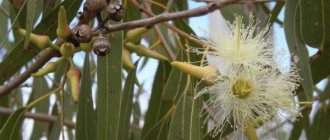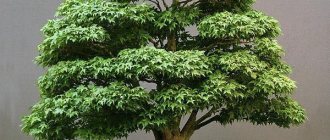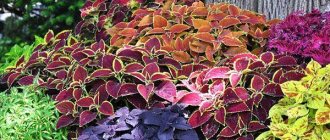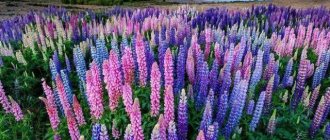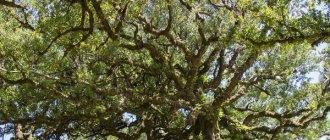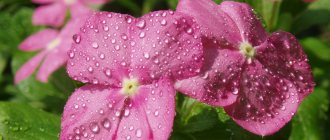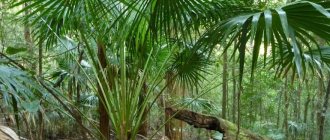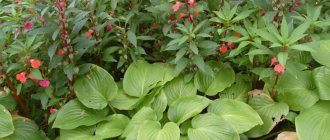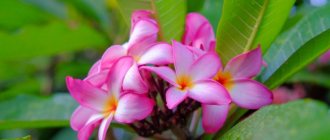Albizia is a genus of the Mimosa subfamily, uniting several species of tropical deciduous shrubs and small trees. The plants are native to several regions, including the Hindustan Peninsula, Iran, Turkey, Thailand, southern China, Japan, and Azerbaijan. Thanks to its ornamental greenery and flowers, albizia is widespread as a greenhouse and home crop in areas with temperate climates.. In areas with mild winters it is grown in open ground.
Botanical description
Adult albizia are densely branched trees or large shrubs up to 10 m high and trunks 15–40 cm thick. The bark is dark gray, finely scaly. The crowns are openwork, wide, umbrella-shaped, their diameter reaches 6–7 m. The root system is superficial, with many long shoots, at the ends of which nodules are concentrated, sensitive to nitrogen compounds. The leaves are dark green or bluish-purple, compound, doubly pinnate . On the central petiole, 17–20 cm long, up to 18 lobes are located oppositely, consisting of 20–30 pairs of small oval plates up to 10 mm long. In the evening, the plates close along the petioles - the leaves seem to close and droop.
In May or June, spicate or capitate bisexual inflorescences of light yellow or white color with many long pink or cream stamens, similar to thin hairs, appear on the albizia. They make the flowers look fluffy.
The fruits are elongated pods 12–18 cm long, with greenish-brown skin. Inside there are seeds - flat beans measuring 7–10 mm.
Albizia is a fast-growing heat-loving species, capable of withstanding periodic short-term temperature drops down to –15 °C, but frosty winters with little snow are destructive for it.
Main types
The following plant varieties are grown in culture:
- Albizia julibrissin. Because of its fluffy inflorescences, it is often called silk tree or silk acacia. In its natural habitat, it is a spreading tree 7–10 m high with a wide crown. The leaves are bright green on the upper side, lighter and matte on the reverse side. There are varieties with purple and lilac leaves. The flowers are fragrant, large, up to 12 cm in diameter, with thick fluffy hairs of pink, cream and red shades. Flowering period is June and July. Under favorable conditions, the buds remain on the branches until September. As a home crop, Albizia Lankaran is grown as a bonsai or compact tree up to 1.5–2 m high.
- Albizia lophantha. The species is of Australian origin. Low trees up to 4 m tall. The leaves are somewhat shorter than those of Lankaran, the inflorescences are spike-shaped, cylindrical, reach a length of 8 cm, and emit a light sweetish aroma. The staminate hairs are bright yellow or cream in color. They bloom in March or April. The flowering period lasts until August.
- Albizia amara. Grows in Eastern and Southern Africa. A shrub 4–5 m high with a spreading wide crown and openwork leaves. The flowering period begins in May. The inflorescences are capitate, fragrant, 3–5 cm in size, with orange pubescence.
- Albizia saman. A large species native to Central America. A massive tree up to 20 m high with a powerful umbrella crown. The branches are fragile and break easily in windy weather. The leaves are bright green, doubly pinnate, with wider blades than other species. The flowers are bright pink with long, dense stamens and emit a sweet aroma reminiscent of violets.
Application
Due to its decorative qualities and exotic appearance, albizia is used in landscape design. In regions with a subtropical climate, its varieties gradually adapt to unusual winter temperatures: trees are planted in gardens and on the streets. In harsher climates it is a houseplant.
Albizia Lankaran is used in folk medicine . The bark and flowers contain a number of pharmacologically active substances:
- triterpenoids;
- glycosides;
- saponins;
- lignans;
- tannins.
Water infusions and decoctions of albizia have anti-inflammatory, antimicrobial, and sedative effects. They are useful for nervous disorders, insomnia, headaches, tachycardia, gastrointestinal diseases, helminthiases, and genitourinary infections.
During the flowering period, the silk tree is a good honey plant . The bark, due to its pigment content, is used as a raw material for the production of natural dye.
Watering Albizia
Watering is carried out as the top layer of soil dries out. Water abundantly, but water should not stagnate in the roots, which is why holes are needed in the growing container.
In winter, watering is reduced. The soil at this time should be only slightly moist, but complete drying out of the earthen ball is unacceptable.
During the growing season, complex mineral fertilizer for decorative deciduous plants is applied once every two weeks.
Growing and care
To cultivate albizia in open ground, you need to choose areas that are well-lit by the sun, protected from wind and strong drafts. Tropical acacia is undemanding when it comes to soil fertility, but does not like clayey, acidified soils. Neutral loose loams or sandstones are preferred for it. Sand and high-moor peat must be added to heavy soil.
Planting is carried out in May, when the soil warms up to 15–18 °C . The seeds must first be soaked for a day in hot water, buried 3–4 cm. The seedlings are placed in holes with a volume twice the size of the plant root system. A layer of stone drainage is placed at the bottom.
Domestic albizia are planted in ceramic pots . For them, a soil mixture is prepared from equal parts of leaf and turf soil, ¼ volume of peat and river sand. You should not choose large dishes - the crop will have to be replanted periodically.
Humidification mode
Albizia loves water very much. It is necessary to water frequently: 2-3 times a week, but try not to waterlog the root system. The top layer of soil should always be slightly damp to the touch. It is recommended to use soft, settled or melted water, heated to room temperature . For watering, take nozzles with fine-jet sprayers.
The air in the room where the culture is kept does not need to be specially humidified. It is enough to water the soil in time and carry out cleaning, removing dust from all surfaces in the room.
Top dressing
In the first year, garden albizia has enough nutrients in the soil. From the second season you can start fertilizing. Fresh manure and other concentrated organic compounds should not be used. It is recommended to purchase complex mineral compositions for flowering plants . Nutrition is added before watering once a year before planting flowers. If the tree develops slowly, fertilizing is repeated at the end of summer.
Indoor albizia are fertilized once a month until the end of the active growing season.
Transfer
Indoor young specimens are replanted annually. The diameter of new pots should be 3 cm larger than the previous ones. Before adding soil, they are washed and disinfected with a strong solution of potassium permanganate. Fresh soil is used.
Transplantation work is carried out at the end of winter or in March, until the plant begins to grow . The root system is carefully lifted with a small spatula along with a lump of soil and transferred to a new container filled with soil about ⅔. Then the roots are carefully sprinkled with the remaining soil. After transplantation, the plant is immediately watered.
Upon reaching the age of 3–4 years, the need for annual transplants disappears. Pots and soil can be updated once every 2–3 years.
Reproduction methods
The most common methods of breeding albizia: seed, cuttings and root shoots. The first method is suitable for garden and indoor crops, but is quite long and troublesome. It is recommended to pre-stratify the material for two months. It can be germinated immediately in a permanent place, in a mixture of sand and peat or in a special agrolite. Sprouts appear within 1–2 months.
Vegetative methods allow you to get new plants much faster . One-year-old lignified shoots are suitable for cuttings. Take their apical parts 10–15 cm long, cutting them at an angle of 45°. The leaves are partially removed, leaving one pair. Before planting in the ground, the cuttings are treated with growth stimulants and deepened 4–5 cm into the sand-peat mixture. Care for them as for adult plants. They develop their own root system in 2–3 months.
Garden crops are propagated by root shoots . It rarely appears in domestic plants. Adventitious shoots are dug up in September, carefully separating them from the mother specimen. The shoots can be planted immediately in permanent places in the garden or grown until the next warm season in pots indoors.
Lighting
Indoor plants are placed on the southwest or south sides. Young specimens will have to be shaded from the bright sun with translucent curtains or blinds. In cloudy weather and evening hours, the lack of lighting must be compensated for by daylight lamps. Direct rays are not dangerous for adult crops.
Garden albizia grow well in open areas and in light partial shade of taller crops.
Temperature
Ideal temperature level for albizia: +22–27 °C. With a gradual increase and timely watering, it is not afraid of hot weather up to +30–33 °C. Indoors, it is recommended to maintain a stable background within +20–25 °C. In summer, in sunny, warm weather, it is recommended to take pots with albizia out into the fresh air.
The plant is afraid of sudden changes both up and down . When switching to winter rest mode, the temperature must be reduced gradually: by 1–2 °C during the day.
Features of winter care
For tropical plants, winter conditions in quite mild subtropics are stressful. Outdoor albizia survive the cold weather quite well under the snow, but severe frosts can destroy them. Young plantings are especially sensitive to them. Before the onset of winter, the soil around the roots must be covered with a thick layer of peat, leaves or sawdust. The crowns are wrapped in thick fabric, thin foam rubber or cardboard. Watering and fertilizing are stopped until March. Mature trees are not afraid of frosts down to –15 °C.
Indoor crops are dormant in winter . They are transferred to a cool room and no longer fertilized. Withered inflorescences and fruits are carefully picked off or cut off. The frequency of watering is reduced to once a month. Albizia that are at rest often shed their leaves even indoors. Before the crop enters the next phase of active vegetation, weak and diseased branches are cut off, sprinkling the cut areas with activated carbon.
Reproduction methods
Albizia can be propagated by seeds and stem cuttings. How albizia is grown from seeds is described above. The process of propagation by cuttings is even simpler.
At the beginning of June, it is necessary to cut off the tops of the side shoots of the current year, approximately 10 centimeters long. It is better to make the cut at an angle. The prepared cuttings should be planted in a container with a mixture of peat and sand and put in a cool place with a temperature of no more than +16 °C. It is necessary to monitor soil moisture and prevent temperature changes. After about 3-4 weeks, the cuttings will take root and will be ready to be planted in separate pots.
Diseases and pests
When planted in suitable soil and following all the rules of care, albizia practically does not get sick. Garden specimens are extremely rarely damaged by parasites. Houseplants can become victims of scale insects and spider mites. The risk of pest attack increases if there are succulents in the same room as the albizia. You can get rid of scale insects by wiping the branches and leaf blades with a swab soaked in insecticide. Brown plaques must be removed manually .
The whitish coating and thin cobwebs entangling the leaves are washed off with infusions of garlic, tobacco dust or onion peels. It is necessary to spray the greens daily until the signs of parasites disappear.
Problems
There are usually no problems with cultivating albizia, but sometimes the following difficulties are possible:
- The plant sheds its buds. Most likely, watering was missed, and in order to preserve the moisture supply, the flower sacrificed reproduction.
- The foliage is withering, although there is still a long time until the leaves fall. There are 2 possible reasons - moisture deficiency or a substrate with poor air permeability.
- Leaves lose color intensity. You need to move the pot to a brighter place.
- Dark spots on leaf blades. This picture is a sign that the flower is in a draft and needs to be moved to a more suitable place.
If you follow all the rules and recommendations, then growing albizia and caring for an exotic plant will bring complete pleasure from contemplating a beautiful, lush and profusely blooming specimen.
Possible difficulties during cultivation
Albizia are capricious and sensitive to changes in usual conditions. Excessive air dryness and insufficient moisture levels lead to paleness, early wilting of leaves and falling flowers. The reason may be excessive water hardness or the presence of lime salts in it.
Waterlogging of roots during watering causes them to rot . The development of rot is promoted by insufficiently loose heavy soil and lack of drainage. In such a situation, it is difficult to save a dying plant. You can try to restore it by rooting the remaining healthy shoots.
The appearance of dark spots on the leaves indicates an incorrect temperature regime: keeping the plant in a draft or in a cold room.

